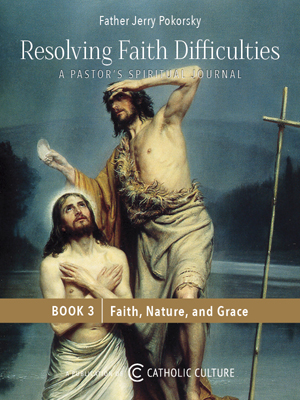Catholic Activity: Spirit of Lent, The
As we begin to enter the Season of Lent, the first step in observing Lent is to develop an understanding of the true spirit of Lent. We must align ourselves with the Church and use this time as inward cleansing and purification.
DIRECTIONS
The great acts of the liturgy during Lent take place in the parish church, and the family members will, of course, take the diocesan and parish programming as their basic guide for the observance of Lent. Yet it is only natural, and surely to be desired, that the laity try to reflect the spirit of Lent through individual and family practices in the intimacy of the home.
The suggestions in this booklet are intended only as a sample of possible Lenten devotions in the home. Those listed are in no way "official," as the Church has never established mandatory rituals for the home. It is not even advisable to try to draw up a schedule for the "average" family, since the circumstances of families vary so much from one to another, and even within the same family as the children grow. Also, it is recognized that there are many laudable customs besides those which are included in this pamphlet.
The important thing is that each family develop its own formula of Lenten practices, with the hope that the spirit of Lent will penetrate our family life as it does the liturgy of the Church during this season. As we reflect on the topic, we discover that it will take as much planning to prepare the family members for the season of Lent as it does to ready the family for Christmas or summer vacation. Decisions have to be made as to what, when, where, and how regarding the various Lenten practices.
The three days, Sunday, Monday, Tuesday before Ash Wednesday, are a good time to prepare for Lent. An occasional discussion between husband and wife and between parents and children helps to set everyone thinking about the way we will observe Lent this year. What will each of us do individually? Do other members of the family think it too much or too little? What will the family do together as a unit? How will we arrange time schedules and make adjustments? What books should we get to read?
Our first reaction is likely to be one of the difficulties involved. It seems that today the American Catholic family faces more obstacles than ever before in trying to observe Lent. Not that there is any threat of persecution or even of ridicule. It is simply that our culture makes such demands on our time and energy that there is no room for anything else. The business and social life whirls on without let-up. Meetings, parties, TV programs, athletic events—all proceed unchanged in number and character right through the Lenten season.
Undoubtedly this is a difficulty? and many people cannot remove themselves to any great degree from the social, business and civic demands made upon them. Frequently, too, the children are held to the same school routine and activities without any recognition of Lent. The challenge is to observe the spirit and works of Lent ourselves while living in a secular culture, to remain in the world but "not of it."
And so we have to ask ourselves: What are the essentials to the observance of Lent? Have we been inclined to emphasize certain favorite external practices, such as giving up sweets, making them the beginning and end of participation? Have the children tended to think of Lent negatively as a gloomy, kill-joy period of repression? If we fail, after a few days, to achieve a dramatic change in the externals of daily life, have we excused ourselves altogether, saying: "I simply can't do it and keep up with my work, or "There's just no time," or "Nobody else is cutting down"? Or worst of all, have we and our children simply forgotten about and ignored the whole idea of Lent?
The Spirit of Lent
The first step in family observance of Lent is to grow in understanding of the true spirit of Lent. We are led, by reading and discussion, to see the purposes which motivate this penitential season. Dom Theodore Wesseling, O.S.B., expresses the Lenten spirit clearly:
Lent is the period of the Church's purification and is at the same time preeminently the period of personal purification. As a period of purification Lent is not merely a period of bodily fasting. It is a period of general readjustment, of thorough renovation from the outer spheres of life down to the roots of its innermost fibres. . . . It is a chastisement of the body in order that the soul may grow. It is purification and liberation. It is a cure, and the fasts are meant to be medicinal. It is a sacred observance, nay, it is direct sanctification. It is the only route to freedom and fulfillment, for it loosens the grip of evil and leads mankind . . . to full and wholesome restoration. . . . If we want to be cured, if we desire sincerely a great spiritual renewal, let us go to the root of the trouble. And the root of the trouble is in our mind and in our heart. (The Cleansing of the Temple, pp. 15-16)This suggests to us that we can join the Church in an inward cleansing and purification with perhaps less external flourish and adjustment than we thought. True, some changes are required and the Catholic family must be prepared to be a bit at odds with the pervading culture. But the difficulties need not be overwhelming. The spirit of Lent can be achieved despite the pressures of a secular culture, for most of the oldest and traditional Lenten practices can be carried out quietly at home.
Father Pius Parsch summarizes the "program for Lent" with this thought:
More important than fasting, prayer, or almsgiving is a perfect Christian life, one which meets and masters every problem that arises. . . . This, then, is your main task: to live perfectly as a Christian, to keep your heart holy, unspotted by sin or selfishness. (The Church's Year of Grace, II, 96.)We now see Lent, not only as mortification, but as an inward purification, for the sake of perfecting ourselves and of showing thereby our love for God. We follow the spirit of the liturgy in the Mass prayer: "Receive, O Lord, this sacrifice . . . and grant . . . that being cleansed by its operation, we may offer to Thee the acceptable tribute of our love" (from the Latin Roman liturgy for Saturday after Ash Wednesday). Christ is the sacrificial Victim. By His Passion and Death He merited salvation for us. During these forty days we will try to make an extraordinary effort to add our small sacrifices to the supreme Sacrifice.
Thus, we enter Lent eagerly. We are not reluctant and depressed by anticipation of the burdens. We realistically acknowledge its demands and its call to special works, but those aspects are overshadowed by the great conviction: this season of Lent and Holy Week shall be a tribute of our love!
Activity Source: Lent and Holy Week in the Home by Emerson and Arlene Hynes, The Liturgical Press, Collegeville, Minnesota, 1977






